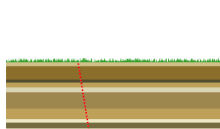
Back تكوين الجبال Arabic Dağ əmələgəlməsi Azerbaijani পর্বত গঠন Bengali/Bangla شکلگیری کوه Persian पर्वत निर्माण Hindi Pembentukan gunung ID Қатпарлық Kazakh Горообразование Russian மலை உருவாக்கம் Tamil Орогенічні рухи Ukrainian


Mountain formation refers to the geological processes that underlie the formation of mountains. These processes are associated with large-scale movements of the Earth's crust (tectonic plates).[1] Folding, faulting, volcanic activity, igneous intrusion and metamorphism can all be parts of the orogenic process of mountain building.[2] The formation of mountains is not necessarily related to the geological structures found on it.[3]
From the late 18th century until its replacement by plate tectonics in the 1960s, geosyncline theory was used to explain much mountain-building.[4] The understanding of specific landscape features in terms of the underlying tectonic processes is called tectonic geomorphology, and the study of geologically young or ongoing processes is called neotectonics.[5][clarification needed]
- ^ Steven M. Stanley (2004). "Mountain building". Earth system history (2nd ed.). Macmillan. p. 207. ISBN 978-0-7167-3907-4.
- ^ Robert J. Twiss; Eldridge M. Moores (1992). "Plate tectonic models of orogenic core zones". Structural Geology (2nd ed.). Macmillan. p. 493. ISBN 978-0-7167-2252-6.
- ^ Ollier, Cliff; Pain, Colin (2000). The Origin of Mountains. Routledge. p. 1. ISBN 978-0-415-19890-5.
- ^ "Geosynclinal Theory". publish.illinois.edu. University of Illinois at Urbana-Champaign. Retrieved March 8, 2018.
The major mountain-building idea that was supported from the 19th century and into the 20th is the geosynclinal theory.
- ^ Kurt Stüwe (2007). "§4.5 Geomorphology". Geodynamics of the lithosphere: an introduction (2nd ed.). Springer. p. 178. ISBN 978-3-540-71236-7.
© MMXXIII Rich X Search. We shall prevail. All rights reserved. Rich X Search